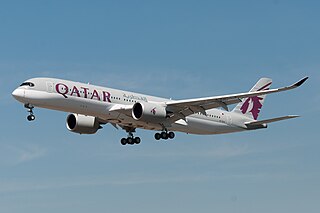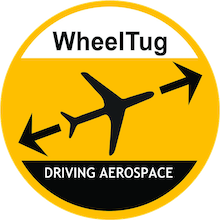
An auxiliary power unit (APU) is a device on a vehicle that provides energy for functions other than propulsion. They are commonly found on large aircraft and naval ships as well as some large land vehicles. Aircraft APUs generally produce 115 V AC voltage at 400 Hz, to run the electrical systems of the aircraft; others can produce 28 V DC voltage. APUs can provide power through single or three-phase systems.

An aerospace manufacturer is a company or individual involved in the various aspects of designing, building, testing, selling, and maintaining aircraft, aircraft parts, missiles, rockets, or spacecraft. Aerospace is a high technology industry.

The Boeing 787 Dreamliner is an American wide-body jet airliner developed and manufactured by Boeing Commercial Airplanes. After dropping its unconventional Sonic Cruiser project, Boeing announced the conventional 7E7 on January 29, 2003, which focused largely on efficiency. The program was launched on April 26, 2004, with an order for 50 aircraft from All Nippon Airways (ANA), targeting a 2008 introduction. On July 8, 2007, a prototype 787 was rolled out without major operating systems, and then the aircraft experienced multiple delays until its maiden flight on December 15, 2009. Type certification was received in August 2011 and the first 787-8 was delivered in September 2011 before entering commercial service on October 26, 2011, with ANA.

Landing gear is the undercarriage of an aircraft or spacecraft that is used for takeoff or landing. For aircraft it is generally needed for both. It was also formerly called alighting gear by some manufacturers, such as the Glenn L. Martin Company. For aircraft, Stinton makes the terminology distinction undercarriage (British) = landing gear (US).

The CFM International CFM56 series is a Franco-American family of high-bypass turbofan aircraft engines made by CFM International (CFMI), with a thrust range of 18,500 to 34,000 lbf. CFMI is a 50–50 joint-owned company of Safran Aircraft Engines of France, and GE Aerospace (GE) of the United States. Both companies are responsible for producing components and each has its own final assembly line. GE produces the high-pressure compressor, combustor, and high-pressure turbine, Safran manufactures the fan, gearbox, exhaust and the low-pressure turbine, and some components are made by Avio of Italy and Honeywell from the US. The engines are assembled by GE in Evendale, Ohio, and by Safran in Villaroche, France. The completed engines are marketed by CFMI. Despite initial export restrictions, it is the most used turbofan aircraft engine in the world, in four major variants.

The Goodrich Corporation, formerly the B.F. Goodrich Company, was an American manufacturing company based in Charlotte, North Carolina. Founded in Akron, Ohio in 1870 as Goodrich, Tew & Co. by Dr. Benjamin Franklin Goodrich, the company name was changed to the "B.F. Goodrich Company" in 1880, to BFGoodrich in the 1980s, and to "Goodrich Corporation" in 2001. Originally a rubber manufacturing company known for automobile tires, the company diversified its manufacturing businesses throughout the twentieth century and sold off its tire business in 1986 to focus on its other businesses, such as aerospace and chemical manufacturing. The BFGoodrich brand name continues to be used by Michelin, who acquired the tire manufacturing business in 1988. Following the acquisition by United Technologies in 2012, Goodrich became a part of UTC Aerospace Systems.
Sir George Herbert Dowty was an English inventor and businessman.

Safran Aircraft Engines, previously Snecma or Snecma Moteurs, is a French aerospace engine manufacturer headquartered in Courcouronnes and a subsidiary of Safran. It designs, manufactures and maintains engines for commercial and military aircraft as well as rocket engines for launch vehicles and satellites.
SIA Engineering Company Limited is a Singaporean company, specialising in aircraft maintenance, repair and overhaul (MRO) services in the Asia-Pacific. It is a wholly owned subsidiary of the Singapore Airlines Group, formed in 1992 with the separation of SIA's engineering division.

The Airbus A350 is a long-range, wide-body twin-engine jet airliner developed and produced by Airbus. The first A350 design proposed by Airbus in 2004, in response to the Boeing 787 Dreamliner, would have been a development of the Airbus A330 with composite wings and new engines. As market support was inadequate, in 2006, Airbus switched to a clean-sheet "XWB" design, powered by two Rolls-Royce Trent XWB turbofan engines. The prototype first flew on 14 June 2013 from Toulouse, France. Type certification from the European Aviation Safety Agency (EASA) was obtained in September 2014, followed by certification from the Federal Aviation Administration (FAA) two months later.

Safran S.A. is a French multinational company that designs, develops and manufactures aircraft engines, rocket engines as well as various aerospace and defense-related equipment or their components. It was formed by a merger between SNECMA and the defense electronics specialist SAGEM in 2005. Safran's acquisition of Zodiac Aerospace in 2018 significantly expanded its aeronautical activities.
Dowty Propellers is a British engineering company based in Brockworth, Gloucestershire that specialises in the manufacture, repair and overhaul of propellers and propeller components for customers around the world. It is owned by General Electric, forming part of its GE Aviation Systems division.

The Boeing 737 Next Generation, commonly abbreviated as 737NG, or 737 Next Gen, is a narrow-body aircraft powered by two jet engines and produced by Boeing Commercial Airplanes. Launched in 1993 as the third generation derivative of the Boeing 737, it has been produced since 1997 and is an upgrade of the 737 Classic (−300/-400/-500) series.
Dowty Group was a leading British manufacturer of aircraft equipment. It was listed on the London Stock Exchange and was once a constituent of the FTSE 100 Index. The firm ceased operating as an individual entity following its acquisition by TI Group in 1992.

WheelTug is a company known for its in-wheel electric taxiing system for airplanes. They are headquartered in the Isle of Man and have manufacturing facilities in Baltimore, Maryland.

An Electric Green Taxiing System (EGTS) is an electric taxiing system which allows aircraft to taxi and pushback without requiring the use of aircraft engines or a pushback tractor, and is designed to reduce fuel volumes used by aircraft and reduce greenhouse gas emissions during ground operations. EGTS technology enables aircraft to avoid using their main engines during taxiing and instead taxi autonomously under their own electrical power, using the Auxiliary Power Unit (APU) generator. The system is designed for single-aisle aircraft, such as the Airbus A320 and the Boeing 737.
Jean-Paul Béchat was a French engineer. He was the CEO of Snecma then Safran until 2007.
Stelia Aerospace is an aerospace company headquartered in Toulouse, France. It specializes in the design and manufacture of aerostructures, pilot seats and premium class passenger seats, mainly for the commercial aviation sector.

The CRAIC CR929, formerly known as Comac C929, is a planned long-range 250-to-320-seat wide-body twinjet airliner family to be developed by CRAIC, a joint-venture between Chinese Comac and Russian United Aircraft Corporation (UAC), to challenge the Airbus and Boeing duopoly. Construction of the first prototype began by September 2021.














